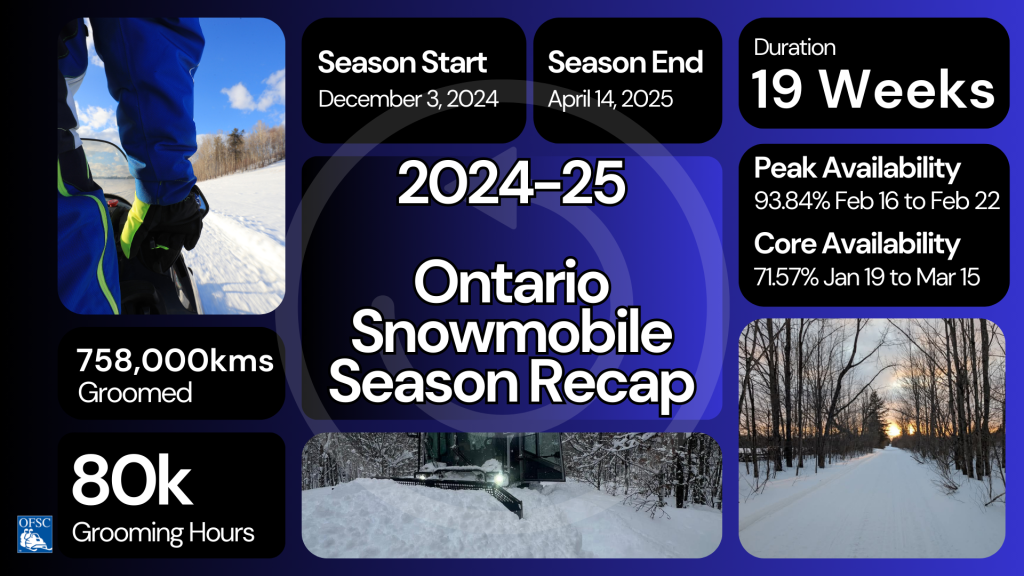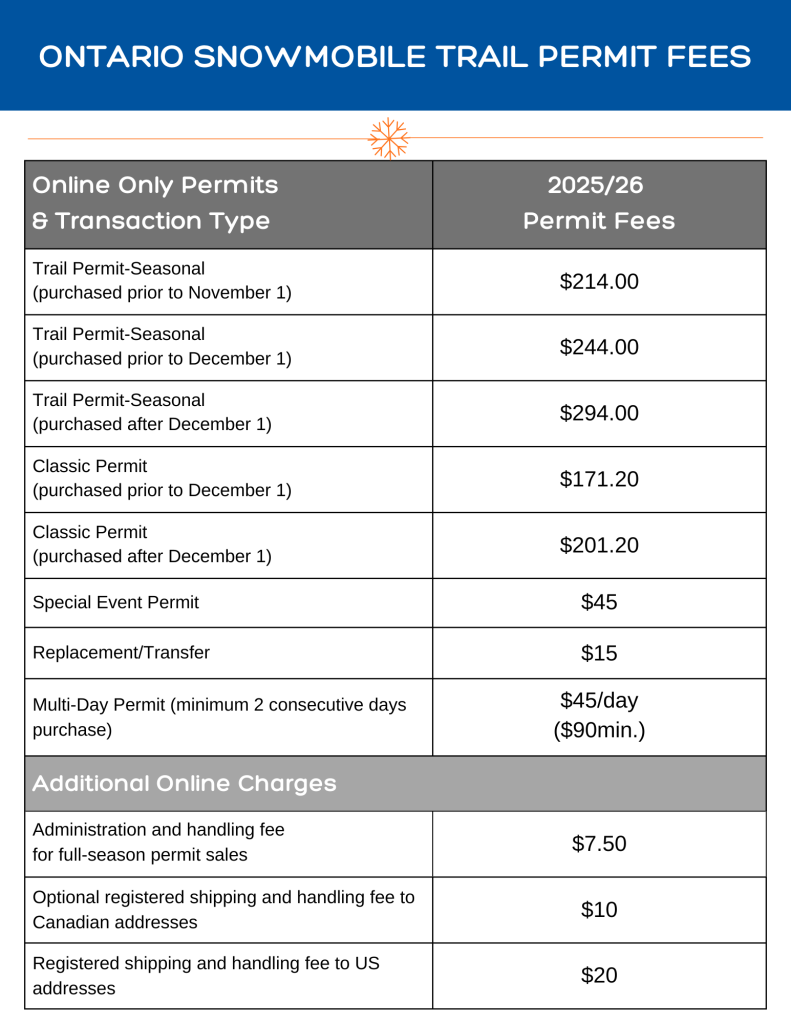
Yes, you read that correctly. It is the time of year when we start to pull our sleds out of storage, try on our gear, and plan for another season of organized snowmobiling in Ontario.
We hope you are as excited as we are for what lies ahead in just a few short months. After a 19-week winter that gave us some of the best snowmobiling conditions in years, we are deeply grateful to our club volunteers, landowners, partners, and you – the permit buyers – who continue to support this sport with passion. Before trail prep kicks into high gear, permits go on sale, and groomers start turning tracks, we wanted to take this opportunity to provide a glimpse into the operational side of our sport. I hope you read on (it’s a long one, but don’t worry – it’s not snowing yet!).

Managing Snowmobile Trails is Expensive
Simply put, rolling out 10’s of thousands of kilometers of white carpet is an expensive endeavour. Even with volunteer blood, sweat, and tears subsidizing this sport to the tune of $16M+ annually in labour and resources, our costs have risen considerably.
Over the last 5 seasons, expenses have increased by approximately 52%, from $17.8M in 2021 to $27.1M in 2025. There are several contributing factors: significant increase in the cost of goods and services we consume (fuel, steel, etc); increased capital investments in our grooming fleet (acquisitions and refurbishment) and infrastructure (bridges, culverts, etc); and increased funding to support our clubs’ trail maintenance and grooming demands. To put this into perspective, the OFSC has invested more than $61.6M into the trail system over the past 3 seasons alone – this includes $35.2M+ towards trail and grooming costs, $8M+ towards 98 infrastructure projects, and $18.3M+ towards 283 total groomer refurbishment and/or replacement projects.
From a revenue perspective, permit sales are the lifeline of organized snowmobiling, but it is a volatile market. Speaking frankly, in this sport, snow sells. When Mother Nature blesses us with favourable conditions and plenty of trail availability, permits fly off the virtual shelf. When conditions are less favourable, there is a noticeable decline in sales. As expenses have increased over the last 5 seasons, total permit revenue has decreased by approximately 6% over the same period, creating further challenges.
Further complicating the matter is the fixed and variable cost component – our fixed costs (ex., pre-season trail and groomer maintenance and prep) exist no matter what the winter brings and are spent long before the snowmobile season begins. Our variable costs (ex., grooming hours and repairs) increase dramatically the more we have to flex them. As an example, clubs groomed 758,000 km of trail last season, clocking a staggering 80,141 hours in the seat; this means we groomed the circumference of the earth 18.9x last winter!
Said differently, the better the season, the happier the riders, but the higher the costs. When permit sales align with these expenses, we strike a perfect balance. When they do not (like last year), it creates a financial challenge.
Sustaining Snowmobiling In Ontario
Why are we sharing this information with permit buyers? The answer is simple – it takes a village to keep this sport going. Over the course of the last 10 months, we have been hard at work exploring ways to ensure snowmobiling can continue for generations to come. Here are three key items to highlight:
- Maintaining Permit Fees: Permits go on sale as of October 1, and fees will remain at the same pricing level as last season, but we need your commitment to make it work. Buying a seasonal permit and riding all winter long is the best way to show your support for the hard work of our volunteers.

- Focusing on Quality vs. Quantity: Annually, the OFSC trail network fluctuates in size, depending on a variety of factors like landowner permission, environmental considerations, etc. The availability of that network then fluctuates even further based largely on local conditions. As one could imagine, 56 years of trail development have created a vast network that is taxing on our current resources. In an effort to both control costs and increase the quality of every kilometre we maintain, the trail network size for the 2025/2026 season will be capped at 25,500 km. The trail network has been locally curated and evaluated to focus our resources on quality, connectivity, and ridership, while removing underutilized, duplicate, and seldomly available trails. While this has indeed been a difficult process, we are confident it will allow us to balance our financial considerations while continuing to deliver an exceptional experience to permit buyers. As you will see once the Interactive Trail Guide (ITG) launches later this Fall, our province and our communities remain connected via a vast snowmobile trail network, which would take your average rider more than 13 years to experience in totality.
- Finding Efficiencies: With no stone left unturned, we are evolving in all aspects of how we operate. As an example, we are optimizing our grooming fleet operations to both maximize the use of the asset and ensure our trail network is groomed based on conditions and demand. By better coordinating our grooming activities province-wide, we are confident your riding experiences will be consistently exceptional, irrespective of where you ride. As a not-for-profit organization, any efficiencies we can realize will go right back on the snow to support our operations in other ways.
A Call to Action — How You Can Help
- Buy a seasonal permit and encourage others to do the same. Permit sales remain the single greatest driver of trail sustainability.
- Support your local club. Whether through volunteer hours or helping at events, every contribution matters.
- Share your story. Let others know how snowmobiling impacts your life, your family, and your community. Real stories make the value of trails impossible to ignore.
- Respect the trails. Protect landowner agreements and help reduce wear and tear so resources stretch further.
Looking Forward Together
Ontario snowmobiling is a community like no other. It is built on passion, tradition, and the belief that winter is meant to be enjoyed. But none of it works without you — the volunteers and riders whose permits keep groomers running and trails available. Your support, understanding, and action today will mean snowmobiling tomorrow, and for many winters to come.
For questions or to schedule a media interview for the week of September 29th, please contact: [email protected]
